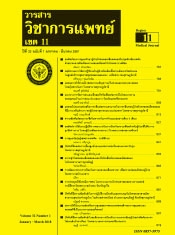Self-management Guideline for Reduction of Diabetes Risk factors in Ban Pakthon community, Chawang District, Nakhon Si Thammarat Province
Keywords:
self-management guidelines,, risk factors,, diabetesAbstract
Diabetes is a major public health problem and has increased rates in all countries. Early detection pre-diabetes risk factors and management of risk factors can delay the development of diabetes. This quasi-experimental study with one-group pre-post test design aimed to determine effects of self-management guideline for reduction of diabetes risk factors. The self-management guideline was develops from evidence based practice, consisted of four steps (1) Diabetes risk assessment and self-management behaviors. (2) Diabetes education and skill training self-management for reduced of diabetes risk factors. (3) Self-management support consisting of a group applications and a home visit and (4) evaluation for pre-diabetes people’s Intergrating lifestyle changes. These guidelines were used with 15 pre-diabetes people who live in Ban Pakthon community, Chawang district, Nakhon Si Thammarat province.The outcomes were assessed by weight mean, Body mass index (BMI), waist circumference and fasting blood sugar. Data were analyzed by using Descriptive statistics, Wilcoxon matched pairs signed-rank test, and content analysis. The results of this study revealed that the pre-diabetes people had significantly decreased weight mean, BMI, waist circumference and fasting blood sugar (p <0.01).Suggestion: Self-management of pre-diabetes people can reduced the risk factors. Therefore, health care team should provide necessary knowledge and skills together with regular follow-up in order to encourage the pre-diabetes people to enhance their self-management behavior.
References
Munden J. Diabetes mellitus: a guide to patient care. The United States of America: Lippincott Williams & Wilkins; 2007.
วิชัย เอกพลากร, ภาวะสุขภาพ, ใน: วิชัย เอกพลากร, บรรณาธิการ. รายงานการสำรวจสุขภาพประชาชนไทยโดยการตรวจร่างกาย ครั้งที่ 5 พ.ศ. 2557. นนทบุรี: อักษรกราฟฟิคแอนด์ดีไซน; 2559.133-195.
งานเวชระเบียน โรงพยาบาลสมเด็จพระยุพราชฉวาง. การจัดกลุ่มโรค: แฟ้มเวชระเบียน. โรงพยาบาลสมเด็จพระยุพราชฉวาง อำเภอฉวาง จังหวัดนครศรีธรรมราช; 2559.
Khoury JC, Kleindorfer D, Alwell K, Moomaw CJ, Woo D, Adeoye O, et al. Diabetes mellitus: a risk factor for ischemic stroke in a large bi-racial population. Stroke 2013; 44:1500-4.
Koopmanschap M. Coping with type II diabetes: the patient’s perspective. Diabetologia 2002; 45:S18-22.
เนติมา คูนีย์. การทบทวนวรรณกรรม: สถานการณ์ปัจจุบันและรูปแบบการบริการด้านโรคไม่ติดต่อเรื้อรัง. กรุงเทพฯ: บริษัท อาร์ต ควอทลิไฟท์ จำกัด; 2557.
ขนิษฐา พิศฉลาด และ ภาวดี วิมลพันธุ์. ผลของโปรแกรมสนับสนุนการจัดการตนเองต่อพฤติกรรม การจัดการตนเองดัชนีมวลกายและระดับน้ำตาลในเลือดหลังอดอาหารของผู้ที่มีภาวะเสี่ยงระยะ ก่อนเบาหวานในชุมชน. วารสารพยาบาลกระทรวงสาธารณสุข 2560; 27:47-59.
นํ้าอ้อย ภักดีวงศ์ และ รัชนีกร ปล้องประภา. ผลของโปรแกรมการจัดการตนเองต่อพฤติกรรม สุขภาพ นํ้าหนัก ดัชนีมวลกายและเส้นรอบเอวของกลุ่มเสี่ยงต่อการเกิดเบาหวานชนิดที่ 2. วารสารสมาคมพยาบาลฯ สาขาภาคะวันออกเฉียงเหนือ 2555; 30:40-47.
เมธินี แหล่งหล้าเลิศสกุล, นิรัตน์ อิมามี, มณีรัตน์ ธีระวิวัฒน์ และ ธราดล เก่งการพานิช. ปัจจัย ทำนายพฤติกรรมการดูแลตนเองด้านการบริโภคอาหารและการออกกำลังกาย ของกลุ่มเสี่ยง โรคเบาหวาน จังหวัดภูเก็ต. วารสารสาธารณสุขศาสตร์ 2556;43:55-67.
ธีรพล ผังดี, ณัฐกฤตา ศิริโสภณ, ประเสริฐศักดิ์กายนาคา, อลิสา นิติธรรม และ สายสมร เฉลยกิตติ. ประสิทธิผลของโปรแกรมการส่งเสริมพฤติกรรมการออกกำลังกายในผู้ป่วยโรคเบาหวาน ชนิดที่ 2. วารสารพยาบาลทหารบก 2560;18 Suppl 1:291-298.






